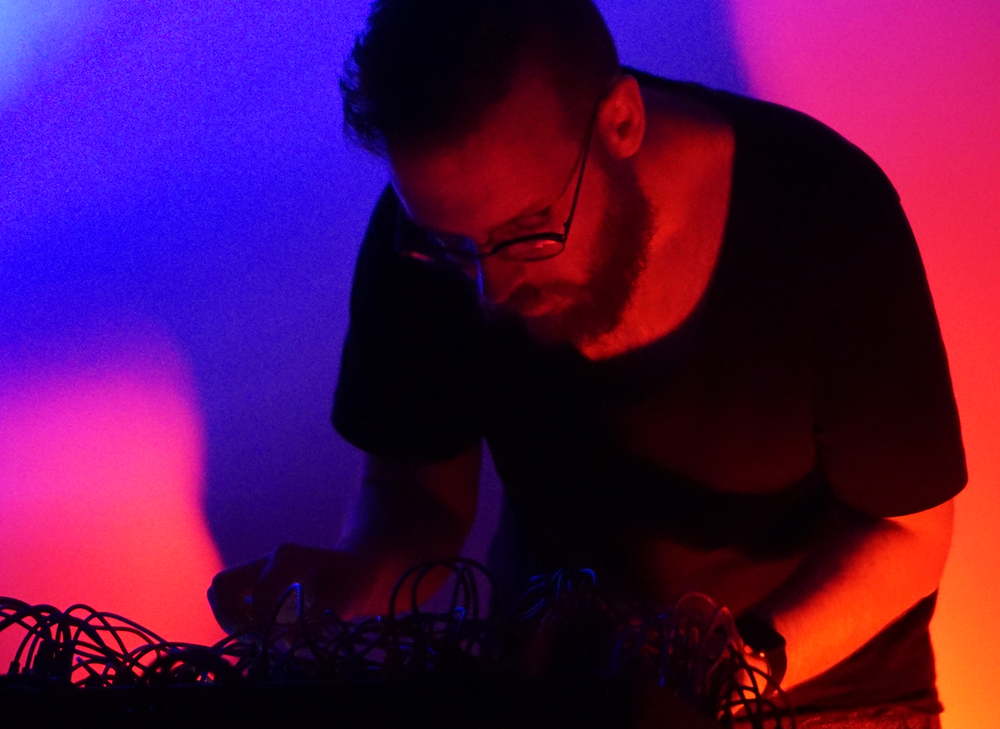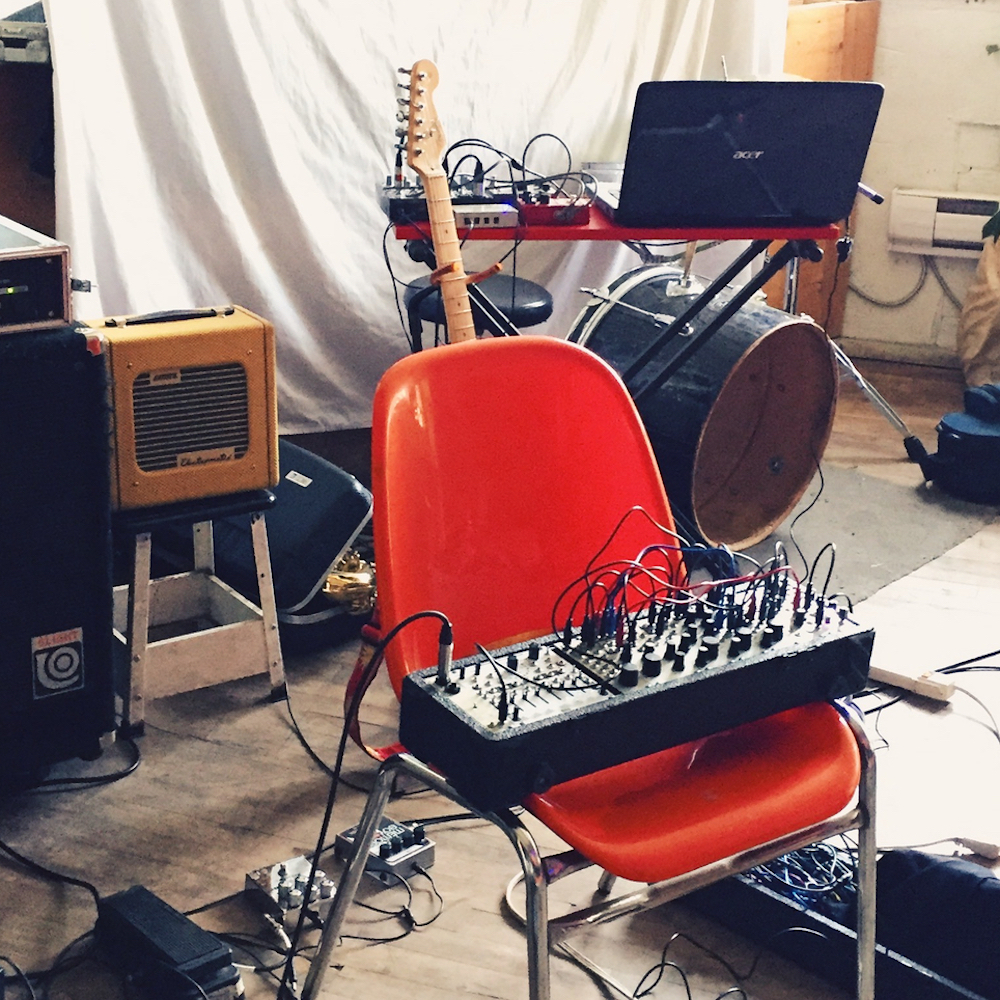
by Jason Caffrey
photo: Connor Bell
“I just mucked around until the machines made a sound.”
Karl Fousek laughs gently as he recalls his first forays into electronic music. Before he was drawn into the world of hardware synthesizers, the Vancouver-based composer and musician experimented with Madrona Labs software.
Multi-faceted VST beasts were too much for him to get his head around in those early days, while more straightforward soft-synths just weren’t “modular enough” to satisfy his appetite for manipulating tone and timbre.
“I couldn't get into the sound enough, so I needed the patch cables.”
Aalto hit the spot.
Fousek was impressed that Randy Jones’ plugin didn’t simply try to emulate venerated vintage West Coast instruments such as the Buchla Easel, but instead took the “synthesis ideals” the hardware embodied, and built on that heritage to forge a new instrument with its own distinct personality.
And he recalls time spent with Aalto as hours of happy exploration and learning.
“I really liked it. It taught me that with any piece of modular kit I could get my hands on, I could approach certain sounds or ideas that were baked into historical instruments. That was a huge lesson.”
Generating spontaneity
Fast forward to the current day, and Fousek is on a very different part of the learning curve. Broadly speaking, he has two primary creative concerns: playing live is central to his music, and he devotes much of his energy to making the electronics—in this case a Eurorack modular setup—work in that setting. Improvisation is a big part of Fousek’s performances, and he is constantly trying “to find a way to make electronics spontaneous, and playable, without losing what’s interesting about those kinds of instruments”.
And while he searches for ways to make his synthesizers perform “more like conventional instruments”, he also devotes attention to the other key aspect of his work: building generative systems that “produce things on their own without much intervention”.
These two strands might appear contradictory. On the one hand, building and refining a playable, responsive setup that can cope with the demands of live improvisation; while on the other, creating systems designed to execute predetermined processes with a considerable degree of autonomy.
But to Fousek, they are simply two sides of the same coin: complementary pathways to navigate in “pursuit of a similar goal.”
Generative composition is something Fousek is, by his own admission, “endlessly fascinated by.” Lacking experience of playing a conventional instrument, he gravitated towards electronic music because it “didn’t require the physical dexterity” demanded by, for example, a violin or a trumpet.
But there was another appeal too: the piano roll—that staple of computer sequencing—held a special allure.
Fousek “didn’t come from a formal trained compositional background,” and discovering music software that laid everything out in front of him “as if it was notated,” was a seminal moment. Indeed, finding “a generative system that didn’t have anything to do with those big Western traditions” was irresistible.
Fousek was hooked.
He also found huge appeal in random patterns. They “made a lot of sense” at the beginning of his musical journey, because a machine-generated sequence that was not strictly predictable gave him a platform to build on.
And while Fousek is now steering his work away from random elements, spontaneity is something that he still values highly in his music.
So how much of his work is composed, and how much is improvised?
“It’s really blurred,” Fousek says, explaining that his different album releases are composed or improvised to varying degrees.
His 2019 album, In The Forest—the soundtrack to a film of the same name by visual artist David Hartt—was, Fousek suggests, “probably the most composed. It had to meet certain requirements and some of the music was edited to visual cues.”
“Because I was working with another artist it had to match the overall project. That said, when I was working on it, there were really really long takes, like 20 minutes of just the machine doing certain processes. A lot of the composition was just going back and editing and juxtaposing some things.”
At the other end of the spectrum, Fousek’s 2017 album, Two Pieces for a Temporary Connection, is “almost all a huge live take.”
“Part of the B-side came straight out of the recording of a show,” he recalls. “The A-side was me rehearsing, doing 20-minute concert-length takes. And then just doing small edits afterwards to make it feel like a piece. It's a really raw, live thing.”
”Almost conducting”
Before taking to the stage for what could be a “loose improvised situation”, Fousek must first prepare his hardware.
That means planning his system setup in advance, deciding how much autonomy his synths will exercise—and how much he will need to intervene in what his machines are doing on their own. Increasingly, Fousek thinks of these preliminary decisions as compositional choices. Software remains an important studio tool, but he hasn’t been able to get comfortable with it on stage.
“The processes I run on a computer seem not to suit the immediacy of being on stage,” he says, and besides, “it’s not very hands-on.”
“I'll often build software patches that do really extended delays and other things that will capture bits of performance and extend them. And for me that works really well when you’re recording. But I find that stuff less easy to control in a live situation.”
The competing demands of improvisation and composed elements require careful calibration ahead of a performance. Which processes will the hardware handle itself? And how can Fousek assume control of any given aspect if need be?
The aim, he says, is to steer the performance, rather than take control of every detail.
Decisions such as the pitch of the next note, or the speed of a certain clock might be set up so that the synthesizer makes those decisions on its own. A feedback loop might, for example, then prompt the hardware to pick a new clock speed every eighth step in a sequence, “so the clock kind of becomes elastic”.
Fousek might restrict the hardware’s pitch range, or program an envelope so that the longer a note is sustained, the “more gnarly” it becomes. In this way he can keep the music flowing without having to command too many knobs and sliders.
“What you're doing when you're playing is you're almost conducting,” he muses. “You're guiding an overall process instead of actively being involved with every little micro part of the sound.”
The burden of pre-planning is lessened when Fousek plays live alongside other musicians, as he did for the 2018 album, Residual Time, which he recorded live in Montreal with saxophonist Yves Charuest and double-bassist Nicolas Caloia.
“I'm responsible for less sound and there's less responsibility for me to make all the transitions.
It’s a situation where Fousek can think of himself as an individual voice, and use a smaller setup for what is more responsive music-making. In a solo performance he is more inclined to let a process “play out for a while.” But in a group improvisation changes “might come faster – there’s a lot of snap decisions”.
“Those guys are also incredible musicians,” Fousek laughs, “so I don't have to worry about them. If I make a really weird sound, they'll figure something out.”
Buying and selling
With seemingly endless options offering limitless possibilities, modular hardware has gained a reputation for being an addictive pursuit. While newcomers might ask themselves where to start, for seasoned synthesists such as Fousek, the bigger problem can be where to stop.
“I have in the past definitely spent too much time online looking at gear and talking about gear, so I'm trying to wean myself off. But I'm not nearly as bad as some people.”
For Fousek, the need to develop muscle memory ultimately trumps the temptation to keep adding or changing modules.
“I don't think I could get any work done,” he insists, and “when you start playing a synth like an instrument, at some point if you're improvising, you need to remember where a certain knob is.
“I mostly work with a small system. You can't change up the rack too much.”
That doesn’t mean that his setup doesn’t evolve. Fousek tends to tailor his synths to a certain project or a piece he has in mind. He’ll play that for a couple of years before making a record, and then he’ll want to move on.
From there, it’s a matter of selling his current modules and spending the cash on new hardware.
It’s a process he says is “getting a little frustrating”, so he’s working more with computers to avoid that.
“I'm trying to build my own synths, to move over some of the processes I've been doing with hardware to computer systems, to just extend them a little bit. But that's a really long-term project.”
Meanwhile Fousek says that while he has no new material ready to be released immediately, he has plenty to keep him occupied.
“I finished an album that was off the tour I did last summer, but that's been sitting on the shelf. I'm not totally pleased with it, so I have to go back to that.”
And, Fousek says, there is “loads and loads of archival work” that he is slowly editing—most of it recorded on borrowed vintage gear.
Musical megalomaniac
Whichever tools Fousek chooses—hardware, software, or a combination of both—it is clear that he will be led by tone and timbre.
“I really like sound, I'm so inside of it,” he enthuses. “That was one of the reasons to get into modular synths - to be inside the sound in a really specific way. I can get it exactly the way I want to be. [...] Before having access to that kind of equipment, I remember being really frustrated.
“With off-the-shelf synthesizers, other people were making decisions about what the sound is. I want to go in and start with just the sine wave or something, and then add on parts, so it's only what I want.
“I don’t know if that sounds megalomaniac?”
Despite this obsession with building bespoke sounds from their most elemental raw materials, Fousek’s music can also nod strongly towards the rhythmic heritage of minimalist composers such as Steve Reich or Terry Riley.
“I do consciously make an effort to think about rhythm and deal with it. I'm interested in sound, and the texture of it, but so much of the music I grew up with is, is rhythmic first in a lot of ways, or doing interesting things with rhythm alongside timbre. I think I have a weird impulse to not want to make purely ambient music, and to not want to make functional dance music—which is mostly I think where people would go to when they think about rhythm.
“I don’t know why. That's just the music I want to make.”
